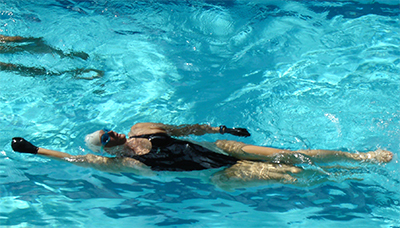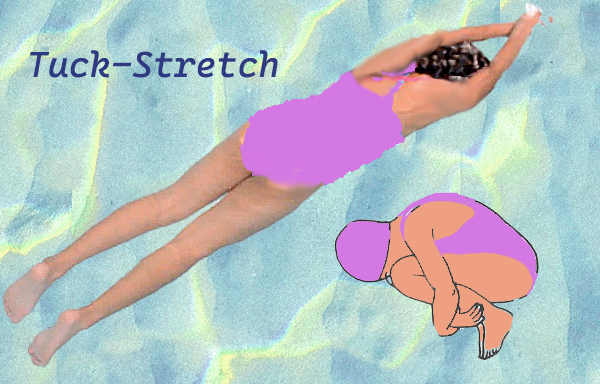To organise your swimming lessons please contact the relevant swimming instructor:
 Private Swimming Lessons with Swim-Easy
Private Swimming Lessons with Swim-Easy
Irene will be happy to answer your questions about learning to swim in her private pool and any other questions you may have about swimming.
Improver swimmers also welcome. People from all over the UK and abroad learn to swim with Irene at Swim-Easy.
 Learn to Swim with Swim-With-Us
Learn to Swim with Swim-With-Us
Working Closely with you, Gay will tailor your residential swimming lessons to suit your individual needs. She is a firm favourite with everyone that has taken private swimming lessons with her. Residential swimming lessons in a private pool. Frightened of putting your face in the water? Panicking in the deep end? Gay has all the time in the world to tailor swimming lessons to suit your individual needs. An ex phobic turned swimming instructor and scuba diver, she understands your fear and frustrations. Learn to swim with Gay!
 Swimming in London and Hertfordshire
Swimming in London and Hertfordshire
Total Immersion trained, Steve is a gentle instructor and has a lot of empathy with the fearful and struggling. You should understand that Total Immersion Coaching is NOTHING to do with getting you underneath the water and EVERYTHING to do with getting your balance and being comfortable while swimming.
![]()
- Swimming Lessons Aberdeen
- Swimming Lessons Aberdeenshire
- Swimming Lessons Anglesey
- Swimming Lessons Angus
- Swimming Lessons Argyll
- Swimming Lessons Ayrshire
- Swimming Lessons Bath
- Swimming Lessons Bedfordshire
- Swimming Lessons Belfast
- Swimming Lessons Berkshire
- Swimming Lessons Berwickshire
- Swimming Lessons Birmingham
- Swimming Lessons Blackburn
- Swimming Lessons Blackpool
- Swimming Lessons Bournemouth
- Swimming Lessons Bradford
- Swimming Lessons Brecknockshire
- Swimming Lessons Brighton
- Swimming Lessons Bristol
- Swimming Lessons Bristol and Avon
- Swimming Lessons Buckinghamshire
- Swimming Lessons Bute
- Swimming Lessons Caernarfonshire
- Swimming Lessons Caithness
- Swimming Lessons Cambridge
- Swimming Lessons Cambridgeshire
- Swimming Lessons Canterbury
- Swimming Lessons Cardiff
- Swimming Lessons Cardiganshire
- Swimming Lessons Carlisle
- Swimming Lessons Carmarthenshire
- Swimming Lessons Channel Islands
- Swimming Lessons Chelmsford
- Swimming Lessons Cheshire
- Swimming Lessons Chester
- Swimming Lessons Clackmannanshire
- Swimming Lessons Cleveland
- Swimming Lessons Colchester
- Swimming Lessons Cornwall
- Swimming Lessons County Antrim
- Swimming Lessons County Armagh
- Swimming Lessons County Down
- Swimming Lessons County Durham
- Swimming Lessons County Fermanagh
- Swimming Lessons County Londonderry
- Swimming Lessons County Tyrone
- Swimming Lessons Coventry
- Swimming Lessons Crewe
- Swimming Lessons Cumberland
- Swimming Lessons Cumbria
- Swimming Lessons Darlington
- Swimming Lessons Denbighshire
- Swimming Lessons Derby
- Swimming Lessons Derbyshire
- Swimming Lessons Devon
- Swimming Lessons Doncaster
- Swimming Lessons Dorchester
- Swimming Lessons Dorset
- Swimming Lessons Dumfries
- Swimming Lessons Dumfriesshire
- Swimming Lessons Dunbartonshire
- Swimming Lessons Dundee
- Swimming Lessons Durham
- Swimming Lessons Dyfed
- Swimming Lessons East Lothian
- Swimming Lessons East Midlands
- Swimming Lessons East Riding of Yorkshire
- Swimming Lessons East Sussex
- Swimming Lessons East Yorkshire
- Swimming Lessons Edinburgh
- Swimming Lessons Essex
- Swimming Lessons Falkirk
- Swimming Lessons Fife
- Swimming Lessons Flintshire
- Swimming Lessons Galashiels
- Swimming Lessons Glamorgan
- Swimming Lessons Glasgow
- Swimming Lessons Gloucester
- Swimming Lessons Gloucestershire
- Swimming Lessons Greater London
- Swimming Lessons Greater Manchester
- Swimming Lessons Guildford
- Swimming Lessons Gwent
- Swimming Lessons Gwynedd
- Swimming Lessons Hampshire
- Swimming Lessons Hartlepool
- Swimming Lessons Hemel Hempstead
- Swimming Lessons Hereford
- Swimming Lessons Hereford and Worcester
- Swimming Lessons Hertfordshire
- Swimming Lessons Highlands
- Swimming Lessons Hull
- Swimming Lessons Huntingdonshire
- Swimming Lessons Ilford
- Swimming Lessons Inner London
- Swimming Lessons Inverness
- Swimming Lessons Inverness-Shire
- Swimming Lessons Ipswich
- Swimming Lessons Isle Of Anglesey
- Swimming Lessons Isle of Man
- Swimming Lessons Isle of Wight
- Swimming Lessons Kent
- Swimming Lessons Kilmarnock
- Swimming Lessons Kirkcaldy
- Swimming Lessons Kirkwall
- Swimming Lessons Lanarkshire
- Swimming Lessons Lancashire
- Swimming Lessons Leeds
- Swimming Lessons Leicester
- Swimming Lessons Leicestershire
- Swimming Lessons Lincoln
- Swimming Lessons Lincolnshire
- Swimming Lessons Liverpool
- Swimming Lessons Llandrindod Wells
- Swimming Lessons Llandudno
- Swimming Lessons London
- Swimming Lessons Luton
- Swimming Lessons Manchester
- Swimming Lessons Medway
- Swimming Lessons Merioneth
- Swimming Lessons Merseyside
- Swimming Lessons Middlesbrough
- Swimming Lessons Middlesex
- Swimming Lessons Midlothian
- Swimming Lessons Milton Keynes
- Swimming Lessons Monmouthshire
- Swimming Lessons Montgomeryshire
- Swimming Lessons Moray
- Swimming Lessons Motherwell
- Swimming Lessons Newcastle Upon Tyne
- Swimming Lessons Newport
- Swimming Lessons Norfolk
- Swimming Lessons North London
- Swimming Lessons North Yorkshire
- Swimming Lessons Northampton
- Swimming Lessons Northamptonshire
- Swimming Lessons Northumberland
- Swimming Lessons Norwich
- Swimming Lessons Nottingham
- Swimming Lessons Nottinghamshire
- Swimming Lessons Orkney
- Swimming Lessons Outer London
- Swimming Lessons Oxford
- Swimming Lessons Oxfordshire
- Swimming Lessons Paisley
- Swimming Lessons Peeblesshire
- Swimming Lessons Pembrokeshire
- Swimming Lessons Perth
- Swimming Lessons Perth and Kinross
- Swimming Lessons Perthshire
- Swimming Lessons Portsmouth
- Swimming Lessons Radnorshire
- Swimming Lessons Reading
- Swimming Lessons Redhill
- Swimming Lessons Renfrewshire
- Swimming Lessons Romford
- Swimming Lessons Ross-Shire
- Swimming Lessons Roxburghshire
- Swimming Lessons Salisbury
- Swimming Lessons Selkirkshire
- Swimming Lessons Sheffield
- Swimming Lessons Shetland
- Swimming Lessons Shropshire
- Swimming Lessons Slough
- Swimming Lessons Somerset
- Swimming Lessons South Yorkshire
- Swimming Lessons Southampton
- Swimming Lessons Southend-On-Sea
- Swimming Lessons St Albans
- Swimming Lessons Staffordshire
- Swimming Lessons Stevenage
- Swimming Lessons Stirling
- Swimming Lessons Stirlingshire
- Swimming Lessons Stockport
- Swimming Lessons Stockton-on-Tees
- Swimming Lessons Stoke-On-Trent
- Swimming Lessons Suffolk
- Swimming Lessons Surrey
- Swimming Lessons Sussex
- Swimming Lessons Sutherland
- Swimming Lessons Swansea
- Swimming Lessons Swindon
- Swimming Lessons Taunton
- Swimming Lessons Telford
- Swimming Lessons Truro
- Swimming Lessons Tyne and Wear
- Swimming Lessons Uxbridge
- Swimming Lessons Wakefield
- Swimming Lessons Walsall
- Swimming Lessons Warrington
- Swimming Lessons Warwickshire
- Swimming Lessons Watford
- Swimming Lessons West Dunbartonshire
- Swimming Lessons West Lothian
- Swimming Lessons West Midlands
- Swimming Lessons West Sussex
- Swimming Lessons West Yorkshire
- Swimming Lessons Western Isles
- Swimming Lessons Wigtownshire
- Swimming Lessons Wiltshire
- Swimming Lessons Wolverhampton
- Swimming Lessons Worcester
- Swimming Lessons Worcestershire
- Swimming Lessons Wrexham
- Swimming Lessons York
- Swimming Lessons Yorkshire



 Every parent wants their child to swim for various reasons, the main one being that they want their child to be able to get out of trouble if they find themselves in the water. This is why swimming lessons are important to the parent.
Every parent wants their child to swim for various reasons, the main one being that they want their child to be able to get out of trouble if they find themselves in the water. This is why swimming lessons are important to the parent.